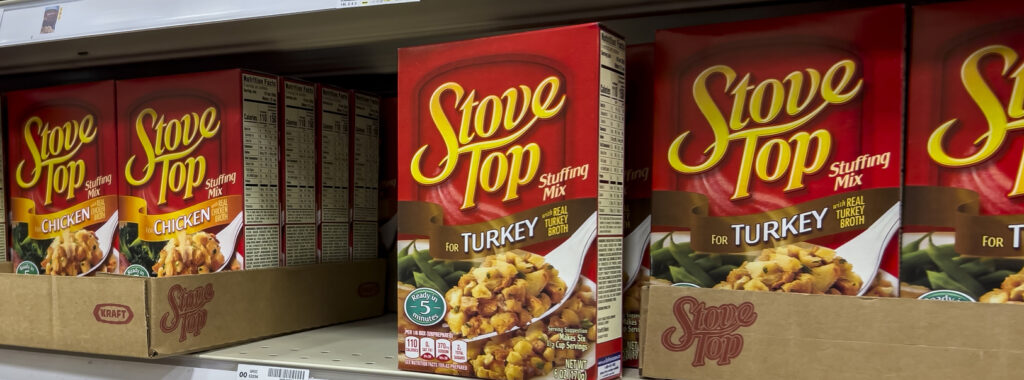Most of us call it stuffing.
It’s got a lot of different names and has been around for a very long time. Probably long before any written records. No one knows for sure.
Look at is this way. You have meat, fish, or another animal ready to roast. No insides. Only an empty cavity crying for something. Why not add vegetables, fruits, spelt (wheat-like grain), nuts, spices – anything that makes it tastier?
The first printed record of stuffing was in ancient times during the reign of Tiberius, the Second Roman Emperor. A famous chef, Marcus Apicius was an ancient merchant known for indulging his appetite and hosting colossal banquets. He wrote what is probably the first ancient cookbook, Apicius – De re conquinaria or “The Art of Cooking.” According to Britannica, the book is “divided into sections based on main ingredients, although unlike them, it does not specify measurements and often omits preparation techniques, simply saying cook until done.”
The meat chapter included recipes for various stuffed critters like chicken, rabbit, pig, and dormouse.
Dormouse?
The Roman stuffing was made from spelt mixed with spices, vegetables, herbs, nuts, and brains.
A brainy dormouse?
It was considered a delicacy.
During the Middle Ages they used stuffing but their mainstay was mostly meat and mutton stews cooked with vegetables.
According to Wikipedia, stuffing was called “farce” (1390), “forcemeat” (1688), and more recently “dressing” (1850).
It wasn’t until the late 1800s when the celebrated French chef, restaurateur, and culinary writer, George Auguste Escoffier, perfected stuffing as we know it today. In his cookbook, La Guide Culinaire, Escoffier designed, prepared, and wrote about turkey stuffed with sausage. Although Escoffier was a dubious character – found guilty of fraud in 1898 – he maintained his popularity.
Perhaps stuffing his pockets gave Escoffier the idea of stuffing a turkey?
Escoffier confessed to taking kickbacks from food suppliers, pocketing bribes, and short-counting expenses all related to the upscale Savoy Hotel in London. The Savoy and Chef Escoffier were loved by the rich and famous. The chefs and staff were loyal to Escoffier and, as one newspaper reported, there was “A Kitchen Revolt in The Savoy” when he left.
Today, whether you’re stuffing, dressing, farcing, or Stove Topping, it’s all basically the same. If you come from the north, you probably eat stuffing; southerners eat dressing. There are differences in cooking – cook it inside the roast and it’s called stuffing; cook it outside (usually baked in a separate dish) and it’s dressing. Sometimes it’s defined by ingredients like Buttery Herb Stuffing and Southern Cornbread Dressing; and sometimes it’s simply Garlic Vegetarian or Low Carb.
While stuffing is one of the most popular side dishes at holidays, it probably wasn’t served at the first Thanksgiving when the Wampanoag Tribe feasted the Pilgrims.
Sorry.
In 1972, stuffing leaped from holidays to everyday.
Ruth Siems was a home economist with a game-changing idea. She took bread, vegetables, seasonings, herbs, and spices and created instant boxed stuffing. Add water, butter or margarine, and it’s ready in 15 minutes.
The first ads sold it as a replacement for potatoes, with chicken or cornbread flavor. It was promoted as “The anytime stuffing that hardly takes any time.”
A few years later pork and turkey flavors were introduced, making it an easy dish for holidays. A new ad boasted, “If it’s not Stove Top, it’s not Thanksgiving.”
Today, Stove Top stuffing sells over 60 million boxes a year and comes in flavors like Lower Sodium Chicken, Beef, and Savory Herbs and Sage. There are books and recipes to “dress up” your Stove Top. KraftHeinz even offers Thanksgiving “stuffing pants” with an extra wide waistband so “you don’t feel guilty about going back for seconds (or even thirds).”
Definitely a necessity.
You can check out National Stuffing Day in November, or add weird stuffing ingredients like Twinkies, corn chips, stale bagels, and popcorn. Try some non-turkey stuffing that people eat around the world, like Turkish Yaprak Sarma (cabbage leaves), Greek Yemista (tomatoes, eggplant, peppers, and rice), and Israeli Lamb (stuffed with parsley, dried fruits, and spices like cinnamon, nutmeg, and allspice).
Whether you’re stuffing, dressing, farcing, or Stove Topping, you can’t go wrong.







Yumm! I will skip the Roman stuffing (!) but the rest of it sounds pretty delicious, and of course from personal experience I am a fan of many different kinds of stuffing- during the holidays of course, but it is good any time of year and I had no idea it was such a huge business. What a fun article, thanks for your entertaining and informative posts!